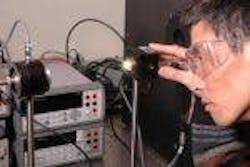NIST researchers describe new approach to LED measurement
The quality of the light produced by high-power LEDs depends on their operating temperature. To speed production, LED manufacturers typically use a high-speed pulsed test at ambient temperature to measure the color and brightness of their products.
However, pulsed measurements do not give the LED chip time to warm to its normal operating temperature. This means that the measured light output quality is not the same as would be realized in actual lighting products.
DC measurements
The lighting industry uses a steady-state DC measurement approach similar to that used for traditional incandescent and fluorescent lamps. This method involves turning the light on, letting it warm up, and measuring the characteristics of the light produced.
Although time-consuming, DC measurement provides a more realistic test of how the lighting product will perform in a consumer’s living room. The problem was that researchers did not understand how the DC measurement results correlated with the pulse measurement results that LED manufacturers use.
NIST scientists Yuqin Zong and Yoshi Ohno have created a standard high-power LED measurement method that satisfies the needs of both LED and lighting manufacturers. The NIST method leverages the fact that the optical and electrical characteristics of an LED are interrelated, and are a function of the LED’s junction temperature (the internal LED chip temperature, which is normally very difficult to measure).
New measurement method
The researchers’ new method entails mounting the LED on a temperature-controlled heat sink set to the desired LED junction temperature between 10 and 100 °C. After applying a pulse of electricity through the LED and measuring the voltage across the junction, scientists turn on the DC power to the LED and adjust the temperature of the heat sink to ensure the voltage has the same value as for the pulsed measurement.
When measuring the light output of an LED, this approach allows researchers to achieve a junction temperature similar to that found in a commercial lighting fixture, rather than performing the pulsed measurement at ambient temperature. The measurement results can be reproducible regardless of pulse or DC operation, or type of heat sink.
The new method also allows the measurement of heat flow in and out of the LED, enabling LED and lighting manufacturers to improve the design of the LED and the thermal management system of the associated lighting product. Effective thermal management is important in lighting products because LEDs perform more efficiently and last much longer at lower temperatures.
Footnote
* Y. Zong and Y. Ohno New practical method for measurement of high-power LEDsProc. CIE Expert Symposium on Advances in Photometry and Colorimetry CIE x033:2008, 102-106 (2008)
